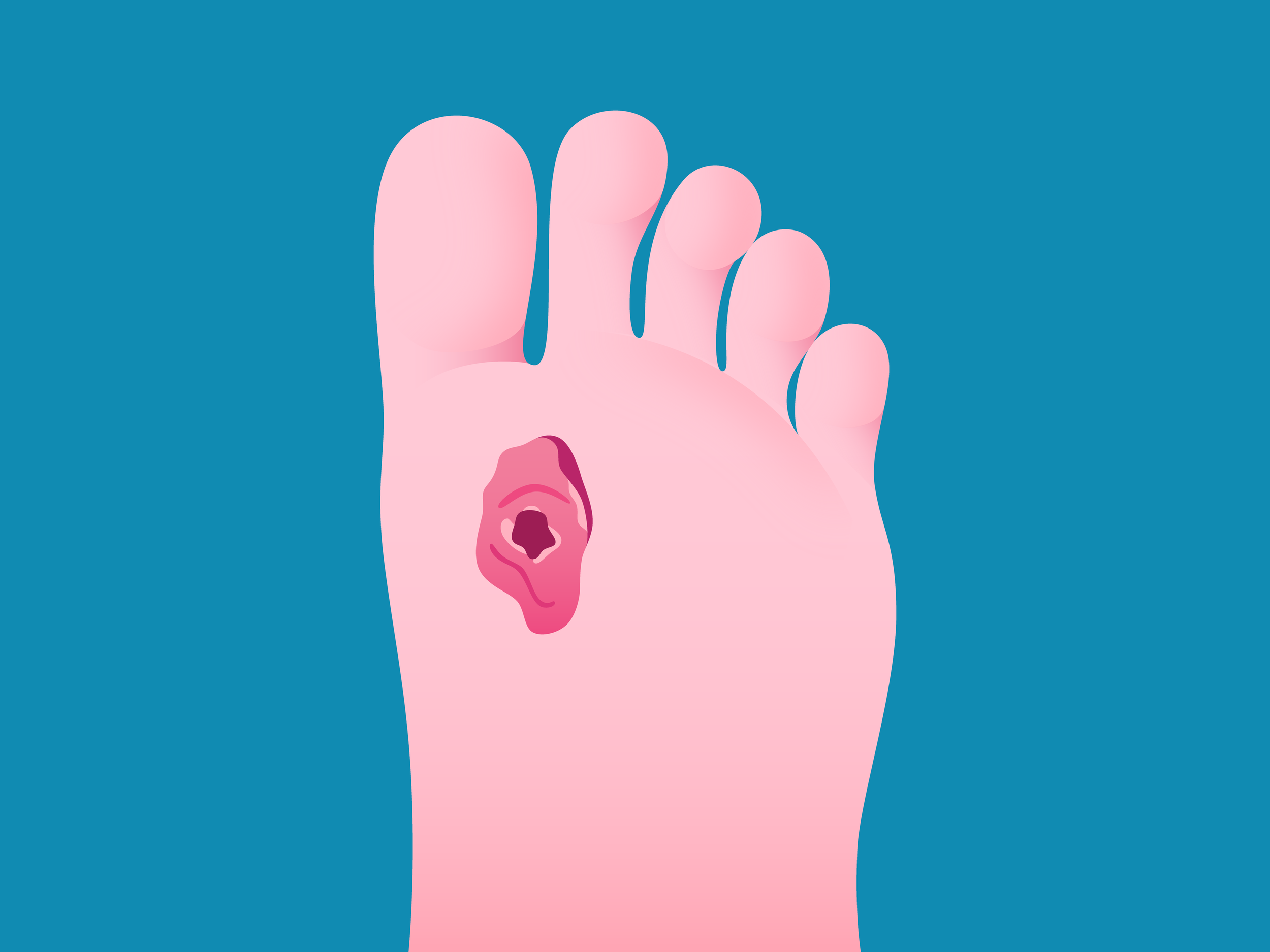Diabetic Wound Care
Diabetic patients are at risk of complications, including slow wound healing. If you have signs or symptoms of diabetic wounds, consult your doctor immediately. Symptoms may include chronic pain, numbness, drainage, inflammation, fever, and/or chills.
What is Diabetic Wound Care?
Diabetic trauma and subsequent infection are due to risk factors inherent in hyperglycemia:
Neuropathy (desensitization to pain from damage to nociceptive nerves): Especially in the feet and lower extremities.
Peripheral vascular disease (PVD): Impedes the health of tissue and the healing from trauma or infection.
Hyperglycemia: Encourages both the neuropathy and the peripheral vascular disease.
Care of wounds in the diabetic center on both the infection aspects and the tissue damage, both of which must be scrupulously attended to prevent the relentless progression that is often seen.
Neuropathy
The integrity of all tissue is negatively impacted by hyperglycemia, and nerve tissue is no exception. Nociceptors are pain receptors that fire off (depolarize) along the nerves that ultimately reach the brain where all pain is perceived. When the nerves are damaged by hyperglycemia, a condition called hypoalgesia begins. This essentially raises the nociceptive threshold beyond which pain sensation is generated.
Numbness and decreased pain response to trauma put the lower extremities and feet at significant risk for unnoticed (unattended and untreated) injury in diabetics.
Peripheral Vascular Disease (PVD)
Low oxygen (hypoxia) is the end-result of diseased blood supply to tissues. PVD thereby affects both the nerves in their function and the tissue negatively impacted by repeated trauma: healing is significantly impaired. Both the arteries and veins in diabetics are affected, and infection from venous involvement is prone to rapid progression.
Hyperglycemia
There is a directly proportional relationship between chronic glucose elevation and neuropathy and peripheral vascular disease, making strict glycemic control the mainstay of prevention and treatment.
Other comorbidities will impact the neuropathy, peripheral vascular disease, and hyperglycemia that results in diabetic risk of trauma and infections:
Obesity.
Dyslipidemia (abnormal cholesterol and triglyceride levels).
Smoking.
Drug abuse.
Types of Diabetic Wounds
The most common diabetic wounds are pressure ulcers and those from lower extremity trauma. Untreated diabetic wounds result in extension of infection and tissue damage, the end-point of which includes sepsis, the need for amputation, and death.
Can Diabetic Wound Care be diagnosed?
Diagnosis of pressure ulcers (“decubitus,” “decubiti,” pl.) and infections and injuries of the feet, lower extremities, and other areas are by inspection. Infection usually is accompanied by odor and a discharge (exudate of purulent secretions). Pressure ulcers in the feet can indicate improper shoe fitting.
Both infected areas and uninfected areas may look the same. The definitive diagnosis of infection is via a culture retrieval from the site and then to test the infectious microorganism against several antibiotics to judge the efficacy of them. This drives the decision of antibiotic choice.
A test for sensation to pain, pinprick, and light touch is necessary to identify problem areas for prophylactic padding.
Peripheral vascular disease may compromise the arterial blood supply to tissues, and an arteriogram can demonstrate areas of poor perfusion. Nerve conduction studies can point out nerve tracts that are not functioning properly.
Diabetes injury occurs because of hyperglycemia, and evaluation of the patient’s glycemic control is done with serial glycated hemoglobin A1c.
Other tests with diabetic injuries should assess the total well-being of the person at risk of cardiovascular, eye, and kidney disease from his or her diabetes. These can be done using ECG, kidney function tests, and a thorough ophthalmological exam.
Management of diabetic wounds is on identification, treatment, and prevention.
Identification
A careful physical appraisal of the diabetic patient in an exam may not be enough to indicate areas of concern. A history from the patient that indicates subclinical preludes to overt disease, such as tingling and numbness.
Pressure points, especially over bony prominences, require additional scrutiny because of possibly more serious bone infection underlying the skin.
Treatment
After identifying infected areas, culturing them, identifying the responsible organism(s), the sensitivity test will indicate the best choice(s) of antibiotic(s). With on-going wound care, scrupulous follow-up with the treating physician will assure that the protocol being used and choice of antibiotics are effective. Treatment failure may indicate bacterial resistance or patient immunocompromise.
The linchpin of management and treatment is strict glycemic control, with counseling with a dietitian/nutritionist, exercise, and avoidance of alcohol to offer the best chance for glucose management success.
Prevention of Diabetic Wounds
Prevention of diabetic injuries and the wounds they cause is first by strict glycemic control, that is, keeping the target hemoglobin A1c level < 7.0.
Injuries that progress toward amputation require prosthetics. Prevention of new injuries from prosthetics is crucial. This is accomplished via fitting by professional prostheticians. Thereafter, routine follow-up re-checks of the equipment is necessary to appraise it for wear-and-tear and changes in the patients that result in ill-fitting.
Arterial compromise as part of peripheral vascular disease can be monitored via imaging studies, including contrast media and ultrasound. Venous compromise may necessitate compression stockings which require great caution to prevent superficial necrosis of the skin.
Aggressive debridement of pressure ulcers and other sites of infection is for stopping their progress, which can pose a risk of sepsis.
Management of hypertension with anti-hypertensive medication is indicated and a routine of periodic evaluations to determine cardiac health will not only improve mortality, but offer extra opportunities for surveillance of healing injuries.
Smoking cessation, a reasonable ADA diet with reasonable expectations, and a team approach that includes the primary care physician, endocrinologist, wound team, dietitian/nutritionist, and when necessary, physiatry and physical therapy.
The best global approach to prevention is by frequent inspection of the feet and legs by podiatry and primary care to identify any areas with warning signals.

